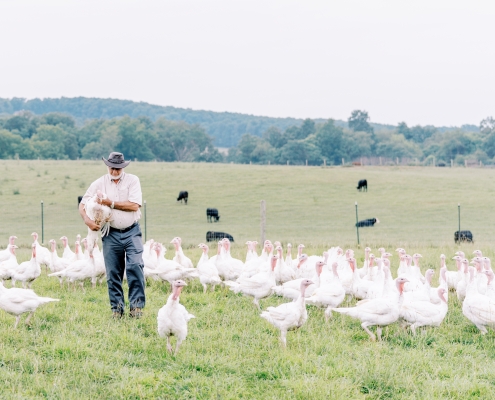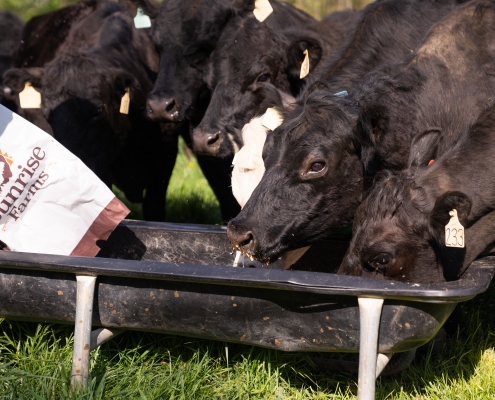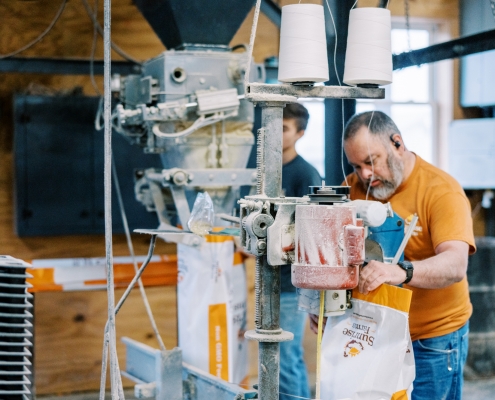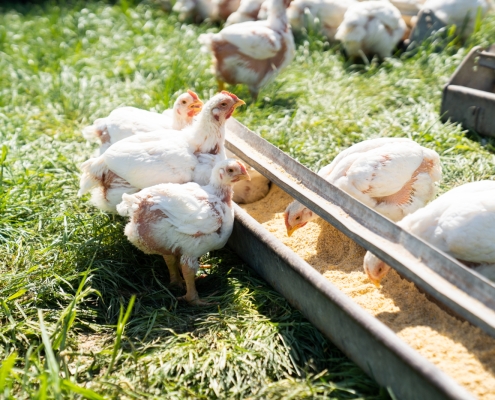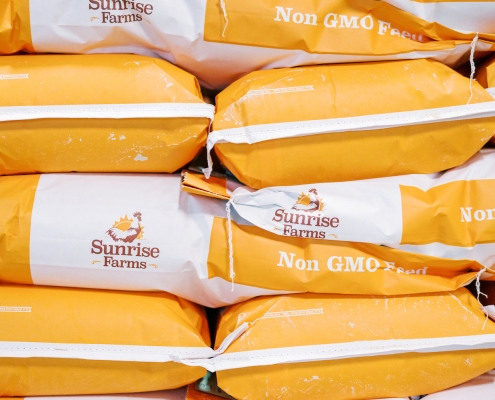What To Know About Micronutrients & Animal Feed
As an all-natural, non-GMO farm, we are focused on every ingredient that goes into our animal feed. Critical ingredients include micronutrients (vitamins and minerals) that play a vital role in proper animal nutrition. We wanted to share what we’ve learned and how we integrate micronutrients into our non-GMO feeds here at the farm.
Vitamins And Minerals Are Crucial Components Of Animal Feed & Diet.
Before diving into the role they play in animal feed, let’s define what micronutrients are. Micronutrients, often referred to as vitamins and minerals, are as vital to animals as they are to humans. Here are the primary distinctions between the two:
Vitamins are organic micronutrients that play an influential role in regulating body functions and resistance to diseases, thereby keeping the body healthy. Examples are Vitamins A, B, C, D, E and K. [1]
Minerals are inorganic (not living) nutrients that participate in different biological processes that drive growth, development and function. Common minerals include calcium, magnesium, phosphorus, potassium, sulfur, zinc, iron, etc. [1]. Within the minerals family, there are also macro and micro minerals. The body needs more macro minerals than micro minerals, thus the distinction between the two terms. [2]
Micronutrients Contribute To Growth, Production & Overall Health.
According to Animal Bioscience, micronutrients are essential components of animal feed and are critical to maintaining health and improving immunity. They play an influential role in fueling the processes that contribute to an animal’s growth, production and health. Some examples of these processes are:
- Forming bones and teeth,
- Maintaining healthy body fluids and tissues,
- Assisting enzyme systems, and
- Supporting normal nerve function. [1]
Just as humans need more or fewer vitamins and minerals at different stages of their lives, like during pregnancy or early life and adolescence, so too do animals. And just like humans, animals with micronutrient deficiencies can experience harmful symptoms that affect their growth, reproduction and productivity. Supplementing an animal’s diet with micronutrients improves their health and enhances their growth and productive performance whether eggs, meat, or milk. [3]
Animals Get Most Micronutrients From Their Diet.
Ideally, an animal’s natural environment, diet, pasture soil composition and water source include adequate vitamins and minerals. But that’s not always the case. For this reason, farmers supplement with micronutrients to prevent deficiencies by adding them to their feed or using feeding blocks or licks. In each of these applications, quality micronutrients matter. [4]
Quality-Sourced Micronutrients Have The Most Nutritional Value.
For years, we’ve partnered with Pennsylvania-based mineral provider Fertrell. They specialize in natural and organic fertilizer and livestock nutrition, and they are committed to using the highest quality ingredients. We trust their team, nutritionist and feed supplement recipes because the better the micronutrient base, the higher the quality of our feed product, leading to healthier animals and products.
Micronutrient sources are not created equal. Here are some examples of the rich, quality sources from Fertrell we recommend:
- Kelp Meal:
According to Fertrell, kelp meal is one of the only plant species full of chelated minerals, vitamins, and phytonutrients. Their research shows that kelp and seaweed have concentrated minerals up to 20 times higher than any land-based plant. Fertrell’s kelp meal is jam-packed with more than 60 micronutrients. [5] It’s also a natural source of iodine that improves thyroid function, regulates metabolism, reduces pink eye and regulates body temperature. [6] Adding kelp to an animal’s diet supports a naturally healthier animal! - Aragonite:
While we don’t currently include Aragonite in our feed, we do sell it and can add it to a custom mix. You’ll often hear of farmers using crushed limestone as a source of calcium carbonate. The benefit of using aragonite is it’s pre-digested, which makes the calcium more available to the animal. [8] Aragonite is found naturally in mollusks and coral, and Fertrell sources it from the Bahamas, where they dredge it out of canals, making it a natural and renewable source. Fertrell has been working with poultry growers to transition flocks from limestone to aragonite. Flocks supplemented with aragonite experience 50% less egg crack compared with limestone. [8] Aragonite is one of those quality sources that pays for itself by producing higher-quality products. - Redmond’s Salt:
We also source our salt from Redmond’s Salt, which is far from your average table salt. Redmond’s Real Salt® is an ancient, unrefined sea salt harvested from a Jurassic Era seabed in Utah. It’s pure, unprocessed and full of 60+ trace minerals that are all naturally occurring, such as sodium chloride, calcium, copper, iodine, iron, magnesium, manganese, phosphorus, potassium, sulfur and zinc. Animals need salt every day, like humans do, to help with many bodily functions like blood flow, reproduction and sweating. Not all salt comes with these extra minerals, so we trust Redmond’s.
Leave Animal Feed Recipe Recommendations To Experts.
Sources aren’t all equal, and neither are animals. Cows are very different from pigs. Chickens are very distinct from sheep. Therefore, the ideal combination and amount of necessary micronutrients is unique to each animal. You get the idea–micronutrients aren’t one size fits all.
Sunrise Farms works closely with Fertrell to get the combinations right for the health and well-being of our livestock and flocks. You can view Fertrell’s site and compare the vast range of vitamin and mineral recommendations by species. If you want to learn more or ask us questions, we invite you to visit our storefront or reach out. The more we learn, the healthier we’ll be.
RESEARCH:
[1] “Importance of micronutrients in bone health of monogastric animals and techniques to improve the bioavailability of micronutrient supplements.” Accessed 04/23. “https://www.ncbi.nlm.nih.gov/pmc/articles/PMC7649403/”
[2] “The Difference Between Macro and Micro Minerals” Accessed 04/23. “https://www.centralagsupply.com/the-difference-between-macro-and-micro-minerals/“
[3] “Micronutrient in Sustainable Animal Production” Accessed 04/23. “https://en.engormix.com/dairy-cattle/articles/micronutrient-sustainable-animal-production-t35722.htm”
[4] Role of Micronutrients in Animal Health. Accessed 04/23. “https://biotecharticles.com/Agriculture-Article/Role-of-Micronutrients-in-Animal-health-3664.html”
[5] “Help Maintain Your Horse’s Health Using All-Natural, Sustainably Produced Products” Accessed 04/23. “https://www.fertrell.com/blog/help-maintain-your-horses-health”
[6] “Micronutrients and Animal Nutrition and the Link between the Application of Micronutrients to Crops and Animal Feed.” Accessed 04/23. “https://biotecharticles.com/Agriculture-Article/Role-of-Micronutrients-in-Animal-health-3664.html”
[7] “ Kelp Meal – Dual Purpose Product.” Accessed 04/23. “https://www.fertrell.com/blog/kelp-meal-dual-purpose-product”
[8] “Aragonite: A Preferred Calcium Source” Accessed 04/23. “https://www.fertrell.com/blog/aragonite-a-preferred-calcium-source”

